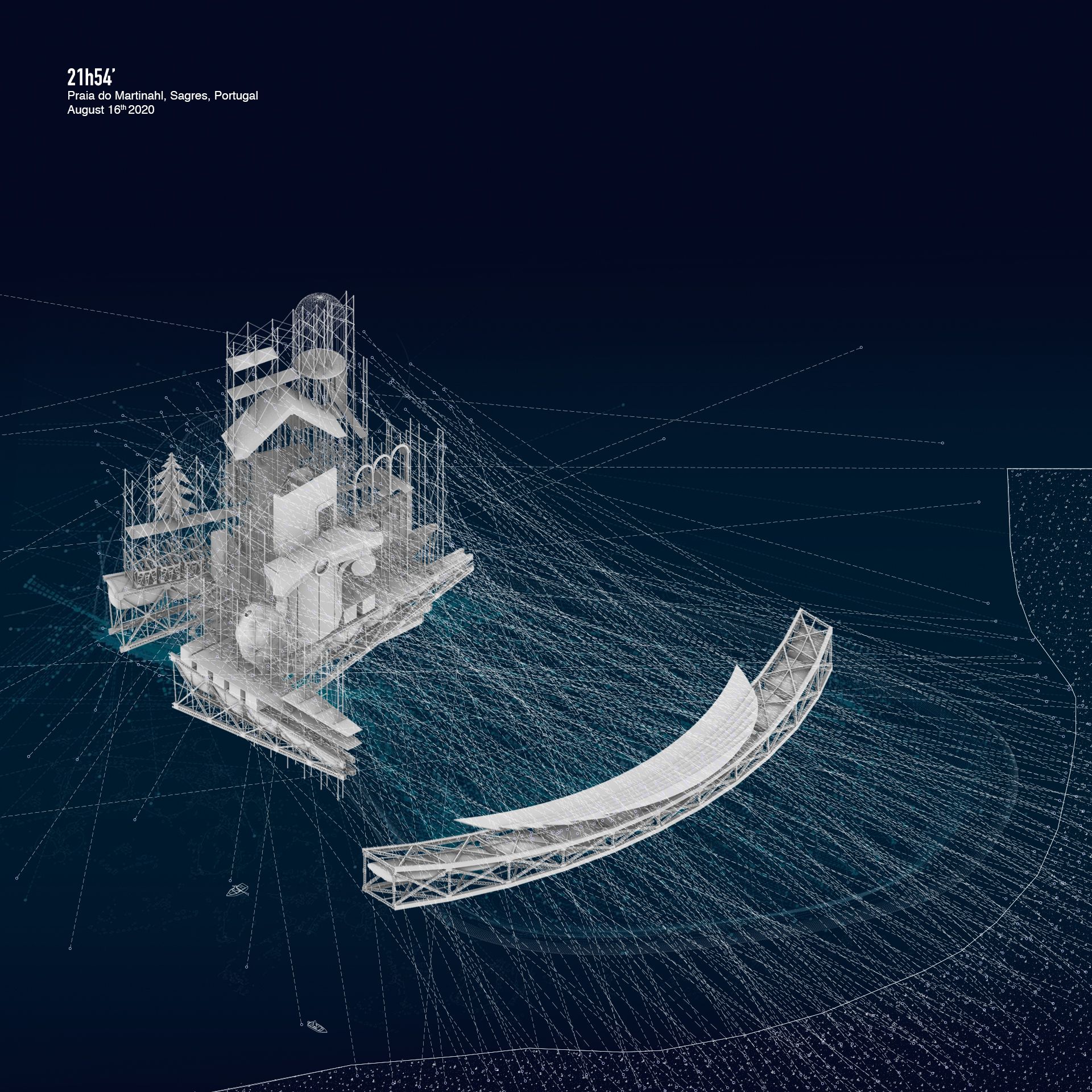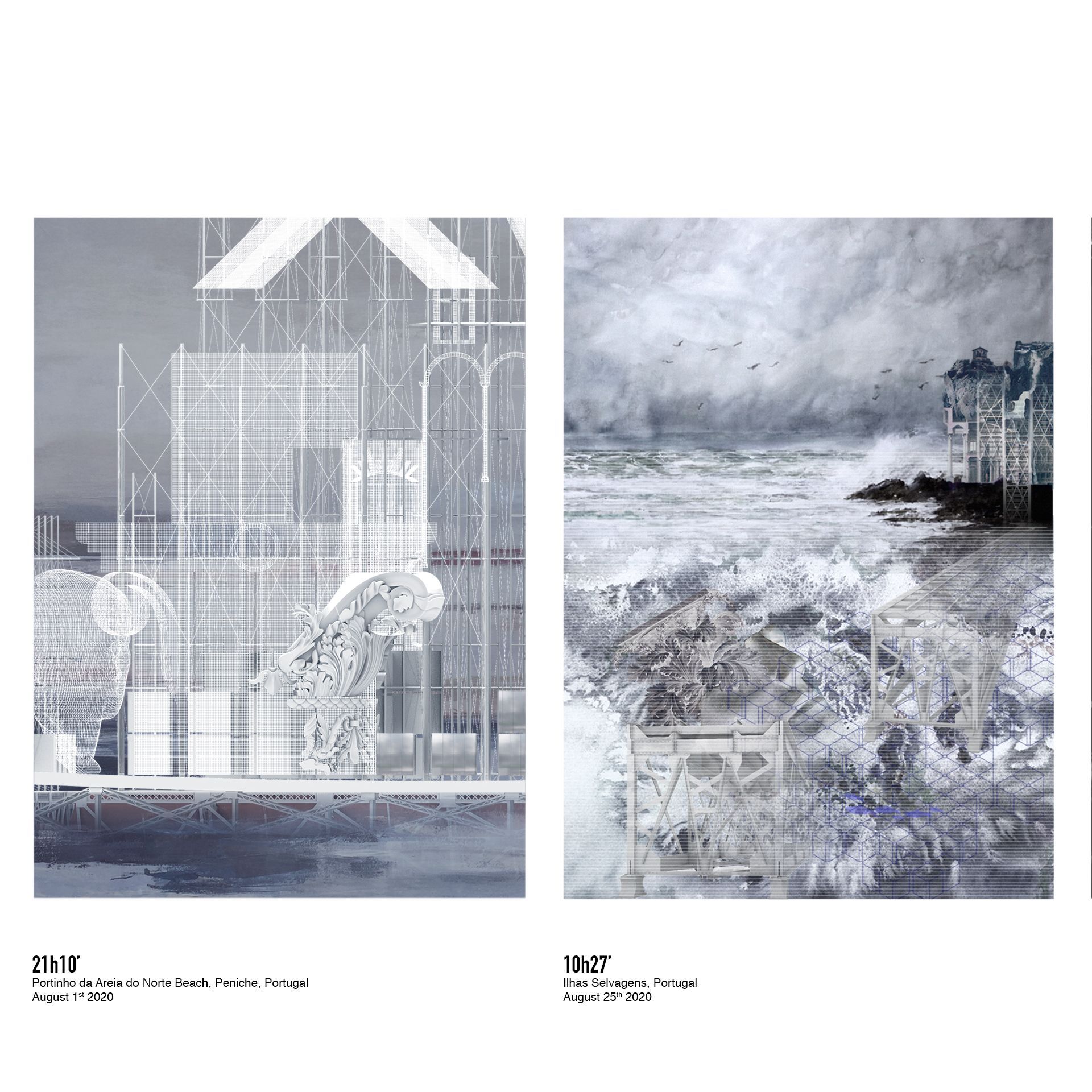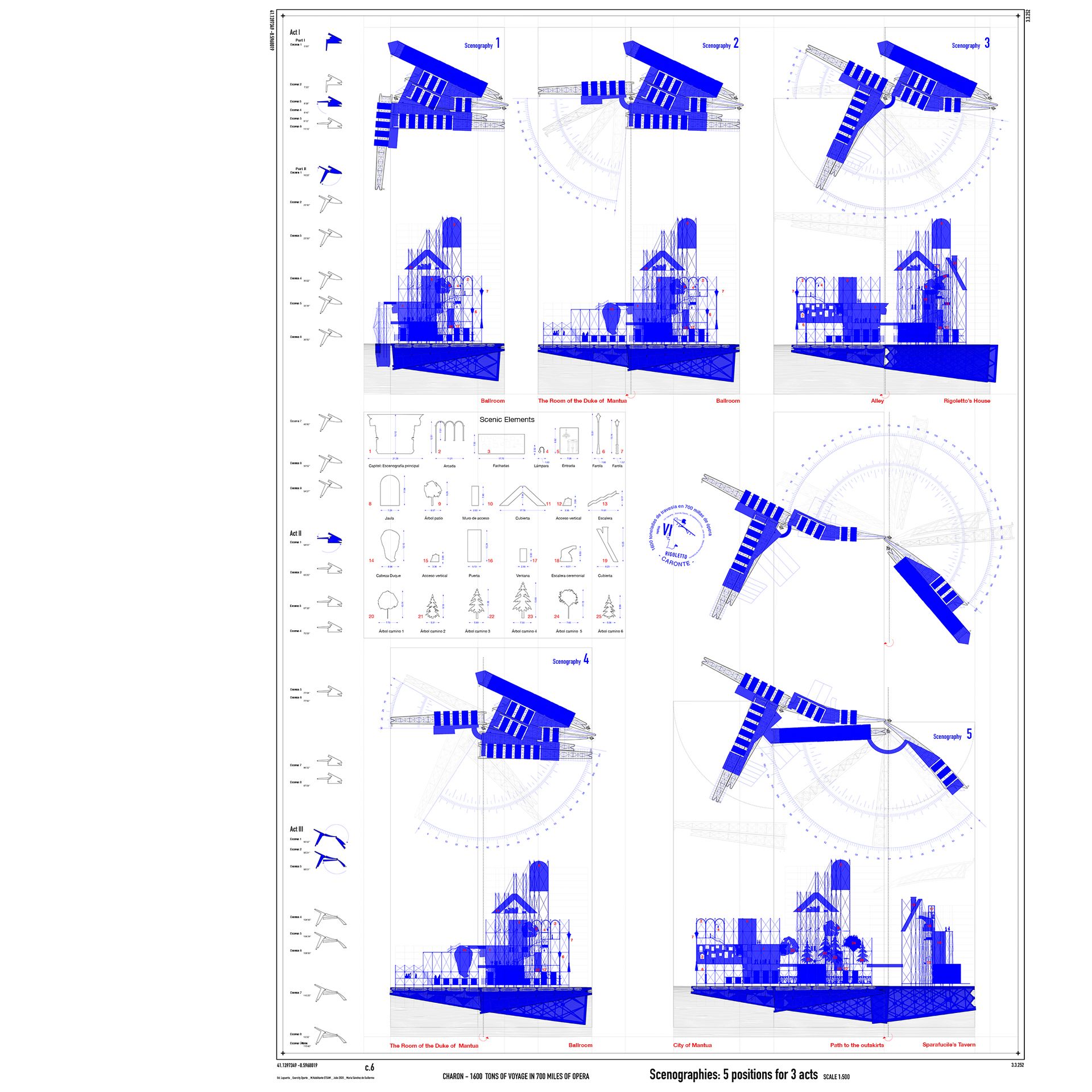Charon is the metamorphosis of Maria Pia, the oldest of Porto’s bridges that was designed by Gustave Eiffel in 1877 and has now been abandoned for 29 years and left to rust. After descending in parts to the Douro river to become a floating opera stage, the legendary sailor travels the ocean on a 700-mile journey through eleven cities on the Portuguese coast with a crew of 70 singers and musicians on board. As part of the Bregenz festival, each night the architecture awakens, the bridge pieces rotate, and the inhabited scenographies overlap and combine to give life to Verdi’s Rigoletto. Charon takes the old iron lady to her last resting place, where sunk in the waters of the Atlantic, she will become an artificial reef and be free from the need to be useful to those who left her to die by the riverbank.
The project builds a sensitive narrative around the critical matter of time and obsolescence faced by today’s architecture. It is based on a strong conceptual research and developed technically and poetically until the connection of these two ends is achieved. History, scale, technique, the scenography of an opera and the domesticity of an ephemeral space become some of the engines of a delicate project based on the need to tell a story.
Charon has been developed at the Technical School of Architecture of Madrid.

KOOZ What prompted the project?
MM The project is originally rooted under the motto Monumental Porto, which was chosen by our unit as a starting point. In the broad sense of the word “Monumental”, the goal was to re-examine the monuments and symbols of the city through a new and creative perspective. Rather than a classic intervention in a chosen example of Portuguese architectural heritage, this was an opportunity to explore new functionalities and configurations, new ideas and limits that would re-shape the city while updating the role of architects in them.
In an initial look at the city’s most relevant constructions, the Maria Pia bridge caught my attention. I was immediately fascinated by its history and elegance and torn by the way in which it had been mercilessly abandoned and forgotten. After the construction of the Sao Joao bridge in 1991, it was left to rust with its arms extended and its hands cut off, trying to reach the riverbank of the Douro. The bridge doesn’t connect Porto and Gaia anymore, it has lost its function and identity, its time over the river was over.
What would happen if historical buildings weren’t necessarily kept intact to be visited as pieces of a museum but rather re-discovered and used as key elements of our modern society? How would cities change if they gave up the ruins that inhabit their streets to solve contemporary issues?
KOOZ What questions does the project raise and which does it address?
MM The main investigation of the project is centered around time and obsolescence. We can no longer afford to conceive buildings as perishable objects that will be used for only a fraction of the time they will stand in place. We live in the era of recycling and architecture cannot fall behind on this matter.
What would happen if historical buildings weren’t necessarily kept intact to be visited as pieces of a museum but rather re-discovered and used as key elements of our modern society? How would cities change if they gave up the ruins that inhabit their streets to solve contemporary issues?
The project envisions a world where old structures become the material to build new ones while maintaining their essence and value. The lyricism of this idea lies in the conception of the full life cycle of the bridge, which is understood to be at a standstill in its current situation of abandonment. Through the eyes of Charon, the bridge is not left unused for hundreds of years more but recharged with new opportunities and purposes. Architecture doesn’t die and rot, its life cycle continues.
KOOZ How does the project deploy narrative as a tool for making and addressing the discipline of architecture?
MM Architecture has always been considered a carrier of messages. It has been used as proof of power, as propaganda and for marketing purposes over the last couple of decades. Fictions, narratives and buildings have been tied up together since the first attempts to understand the world around us. In Charon, the almost literary conception of the project was a crucial tool for its own development. Due to what was previously established regarding the re-use of the iron pieces, it was very important to make a sensitive approach to Gustave Eiffel's project that would show the dismantling of the structure as a sign of respect and opportunity towards it and not as a mere dismemberment of the bridge. The personification of Maria Pia allows an almost intimate approach to the structure that brings us closer to its architecture and to the understanding of the project’s intention: the conclusion of the bridge's chronology.
Paul Ricoeur said that "cities and architecture are stories that come together in the past, the present and the future." However, and responding to the previously established questions, on many occasions European cities are currently romantically and selfishly anchored in the past. The use of a narrative sequence in Charon serves in this case to continue the story of the bridge, thus showing its future possibilities.
KOOZ How would you define the contemporary state of architectural production?
MM Frenetic. Surprisingly, contemporary architecture continues to be produced outside of urban, social and climatic needs as a tool to generate profit. The industrialization and mechanization of many architectural processes has accelerated construction and cities are growing at exorbitant speeds. However, in many cases we continue to fail when it comes to reusing those buildings that have been left behind and heritage interventions are generally reduced to the careful reproduction of their appearance and previous use.

KOOZ How does the project act as a critique to the above?
MM Architecture does not necessarily mean building walls and creating things. In many cases it is possible to build more and better by not doing, redoing or undoing, actions that guarantee economic, social, cultural and environmental sustainability. The project is a critic of the abandonment of structures that become unused after the construction of new ones that replace them in use. The speed of architectural production often does not leave space for the treatment of these buildings and it is economically more profitable to forget about them in the city. Meanwhile, those buildings that are restored, often limited by urban regulations, are subjected to cowardly solutions that do not exploit their full potential.
Charon is a strong bet on courage when planning alternative uses for existing architectures. The bridge escapes its confinement over the river, it is taken down in pieces and assembled using balloons to keep it afloat and metal masts to inhabit it. The bridge becomes a floating opera house and receives the honorable farewell it deserves for the service rendered to the city of Porto and Portugal, before regaining a new peaceful mission under the ocean waters.
In our days, the abuse of construction to which we have been pushed due to the increasing demand, has in many cases removed architecture from this necessary intimacy that transforms mere materials into architecture. As architects we must seek a new approach to the profession.
KOOZ What role should the architect play within our contemporary society?
MM An architecture project is inevitably a personal process, we could say an almost intimate process, in which all those things that are acquired over time come together. In our days, the abuse of construction to which we have been pushed due to the increasing demand, has in many cases removed architecture from this necessary intimacy that transforms mere materials into architecture. As architects we must seek a new approach to the profession, in response to the difficulties, degradation and manipulation of the current architectural scene. It is about operating on an emotional level in front of architectures that operate in the merely material field and are directly empty of content; architectures that say nothing compared to those in which the emotion of their creation exposes their reality.
I also believe that we must be a generation of architects that manages to continue opening and exploring the possibilities of a profession that is both art and science, drawing on and intertwined with psychology, sociology, economics, politics, scenography and many more. We can’t claim sole authorship of ourprojects anymore. Rather, architecture today is the epicenter of interactions of the work of others and it is our role to find the place where we belong to in that exchange.

KOOZ What is for you the architect's most important tool?
MM Perspective and the ability to adapt. The education that is provided to us as architects continues to be one of the most complete ones today. This allows us to participate in a wide range of projects of different nature as long as we know how to adapt to different environments. Architects need to be ready to react when faced with unexpected issues. We need to be able to intervene in existing situations, to be able to read and re-write the suffering of a space that is already embedded in its materiality, and reenact it in a way that improves the city, the buildings and life inside them.
During my studies, something that I learnt exponentially over the years was the value of incorporating references from different sources, fields and scales to the design process. It is truly fascinating how architecture makes it possible to study the constructive detail of a hot air balloon to make a bridge float or nautical cartographies to draw the movements of a soprano on the stage.
Bio
María Melero is a recent architecture graduate from the Technical School of Architecture of Madrid. Since the last year of her bachelors degree she has been deeply interested in the theater arts and their relationship with architecture. After finishing her Bachelor Thesis, which was based on the study of architectural spaces through the work of scenographer Adolph Appia, she started working as a stage designer in Lisbon. She has also worked as an intern and as a collaborator afterwards with Swiss architect Daniel Zamarbide in his Portuguese studio, BUREAU. After finishing her Masters degree with Honors in July 2020 she started working with Federico Soriano. She is still working on her personal projects, mainly scenographies for theaters in Madrid.

